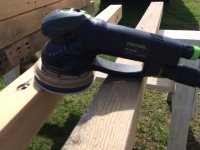- Joined
- Nov 24, 2011
- Messages
- 2,004
Interface pads are often associated with conforming to interior profiles, which they do very well in many cases.
There are also 2 places on exterior projects where interface pads are Life Savers in my work:
1. Sanding deck boards that are cupped...allows conformity to the center and softens out the outer edge of the abrasive disc.
2. Low grit sanding into deeply pronounced grain. Hard pad into this stuff just beats up abrasive edges, and once there is a tear in the abrasive, it is swirl city. The interface can cut into deeper grain easier. Its "wobbly" nature is actually a good thing, as there is very little flat spotting the way it floats in a stack. Lately, the ETS 150/5 and RO150 have been the sanders I have been using this approach with.
Extraction isn't compromised by it, as the holes align perfectly. So if you have them sitting around, put them to work. Not everything in the world of sanding is flat.
Anyone else find these things to be pretty handy?
[attachimg=1]
There are also 2 places on exterior projects where interface pads are Life Savers in my work:
1. Sanding deck boards that are cupped...allows conformity to the center and softens out the outer edge of the abrasive disc.
2. Low grit sanding into deeply pronounced grain. Hard pad into this stuff just beats up abrasive edges, and once there is a tear in the abrasive, it is swirl city. The interface can cut into deeper grain easier. Its "wobbly" nature is actually a good thing, as there is very little flat spotting the way it floats in a stack. Lately, the ETS 150/5 and RO150 have been the sanders I have been using this approach with.
Extraction isn't compromised by it, as the holes align perfectly. So if you have them sitting around, put them to work. Not everything in the world of sanding is flat.
Anyone else find these things to be pretty handy?
[attachimg=1]

